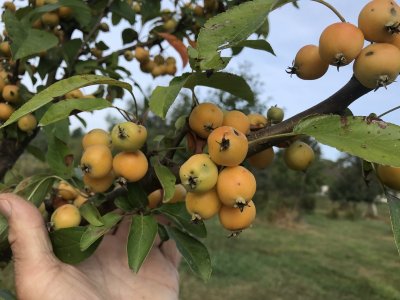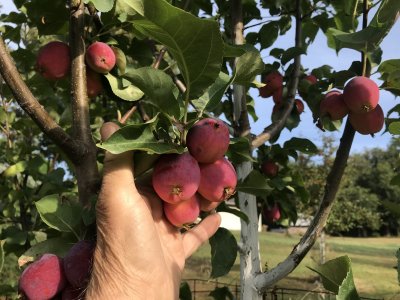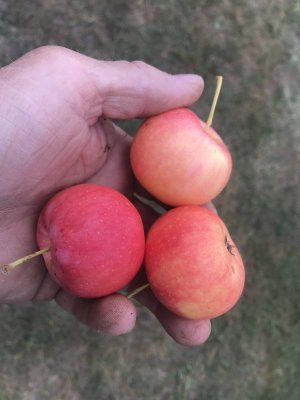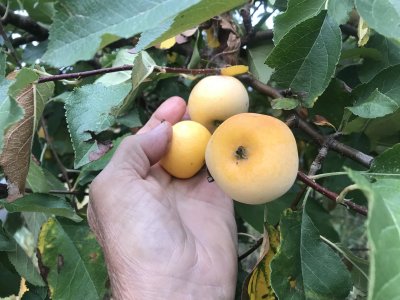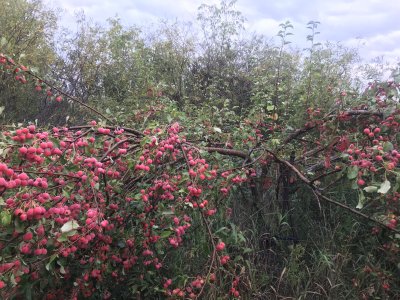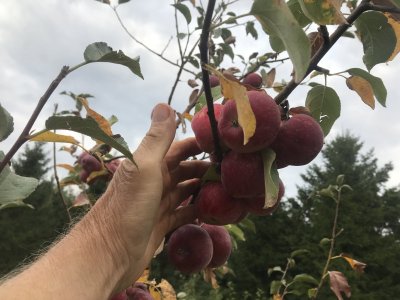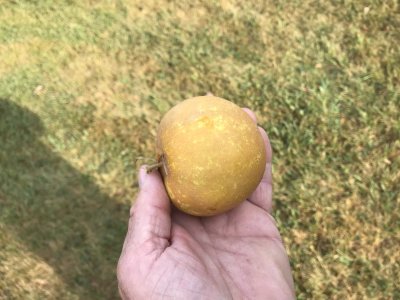-
If you are posting pictures, and they aren't posting in the correct orientation, please flush your browser cache and try again.
Edge
Safari/iOS
Chrome
You are using an out of date browser. It may not display this or other websites correctly.
You should upgrade or use an alternative browser.
You should upgrade or use an alternative browser.
Crabapple timeline
- Thread starter sandbur
- Start date
4wanderingeyes
5 year old buck +
I have a ton of apples on the ground right now of many varieties, I don’t see much for deer tracks around the apple trees. I assume because of all of the acorns. I haven’t put any cameras out yet, but I will start putting them out this week. I use to run the 365/24/7, but the cost of batteries put a stop to that.
rocksnstumps
5 year old buck +
A 2023 update on Ranetka seedlings with several years of pics in past pages of this long thread. Maybe someday will try to group them better. In general these are 1" to 1-3/4" sized crabs with various drop times. A few are fair eaters, sweet but not as tasty as say a chestnut crab.
Ranetka A is typically early Sept ripen and drop for a few weeks. This tree was the first to fruit and consistent decent crops with nice form.
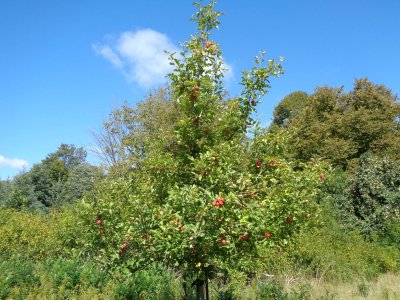
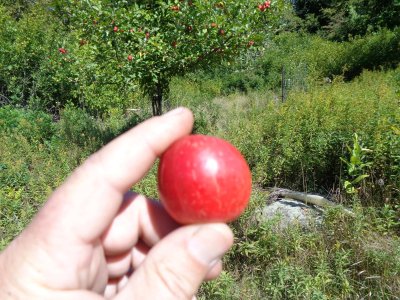
Ranetka B has started dropping some a bit earlier this year but in years past has held some into later Oct. This crab when ripe is fairly sweet and not bad. It also has suffered the most critter damage with the top and a major branch or two getting trashed while a young tree
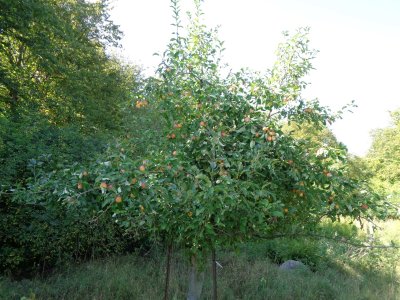
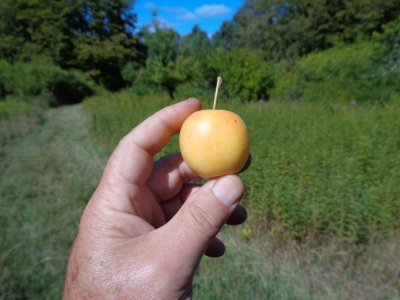
Ranetka C another Sept tree and ok to eat with a dolgo looking oblong shape. Sweet when fully ripe but a bit of an aftertaste for a finish tho.

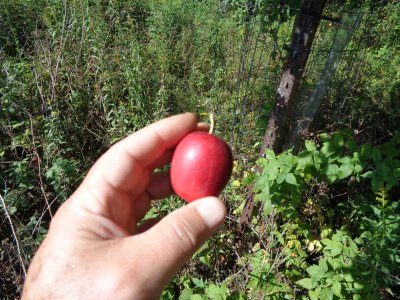
Ranetka D had very few fruit last year so normal drop time is a bit sketchy but nothing under this tree yet.

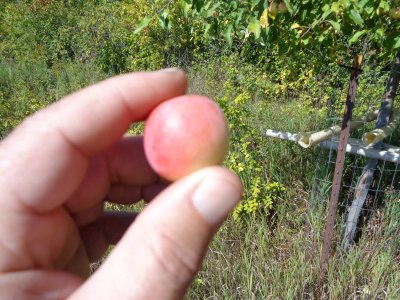
And the new kid on the block Ranetka E. While all trees planted at same time, this one has taken several more years to bear fruit. Right now hard as a rock and not even close to coming off. I tugged fairly hard and finally just took a pic while still attached. But being the first year with any fruit will see if this trend extends into later years.
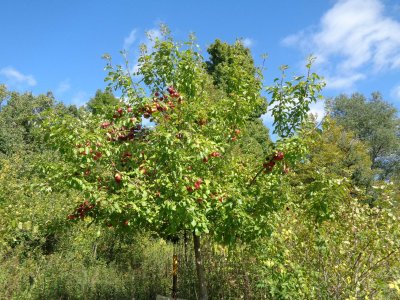
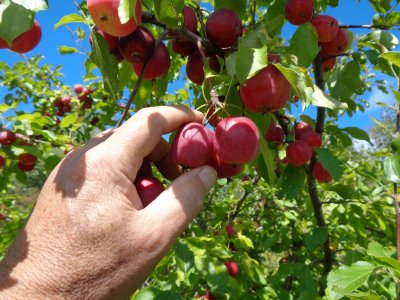
So there you have it. Was hoping that a couple more Ranetka besides these would make it but think a potential Ranetka F is now toast/overwhelmed with a prickly ash advancement on a steeper slope which is also a bit more challenging to grow stuff when dry years hit.
Ranetka A is typically early Sept ripen and drop for a few weeks. This tree was the first to fruit and consistent decent crops with nice form.


Ranetka B has started dropping some a bit earlier this year but in years past has held some into later Oct. This crab when ripe is fairly sweet and not bad. It also has suffered the most critter damage with the top and a major branch or two getting trashed while a young tree


Ranetka C another Sept tree and ok to eat with a dolgo looking oblong shape. Sweet when fully ripe but a bit of an aftertaste for a finish tho.


Ranetka D had very few fruit last year so normal drop time is a bit sketchy but nothing under this tree yet.


And the new kid on the block Ranetka E. While all trees planted at same time, this one has taken several more years to bear fruit. Right now hard as a rock and not even close to coming off. I tugged fairly hard and finally just took a pic while still attached. But being the first year with any fruit will see if this trend extends into later years.


So there you have it. Was hoping that a couple more Ranetka besides these would make it but think a potential Ranetka F is now toast/overwhelmed with a prickly ash advancement on a steeper slope which is also a bit more challenging to grow stuff when dry years hit.
sandbur
5 year old buck +
That E might end up being a good winter feed source. Thank you for posting.A 2023 update on Ranetka seedlings with several years of pics in past pages of this long thread. Maybe someday will try to group them better. In general these are 1" to 1-3/4" sized crabs with various drop times. A few are fair eaters, sweet but not as tasty as say a chestnut crab.
Ranetka A is typically early Sept ripen and drop for a few weeks. This tree was the first to fruit and consistent decent crops with nice form.
View attachment 57089
View attachment 57091
Ranetka B has started dropping some a bit earlier this year but in years past has held some into later Oct. This crab when ripe is fairly sweet and not bad. It also has suffered the most critter damage with the top and a major branch or two getting trashed while a young tree
View attachment 57092
View attachment 57093
Ranetka C another Sept tree and ok to eat with a dolgo looking oblong shape. Sweet when fully ripe but a bit of an aftertaste for a finish tho.
View attachment 57094
View attachment 57095
Ranetka D had very few fruit last year so normal drop time is a bit sketchy but nothing under this tree yet.
View attachment 57097
View attachment 57098
And the new kid on the block Ranetka E. While all trees planted at same time, this one has taken several more years to bear fruit. Right now hard as a rock and not even close to coming off. I tugged fairly hard and finally just took a pic while still attached. But being the first year with any fruit will see if this trend extends into later years.
View attachment 57099
View attachment 57100
So there you have it. Was hoping that a couple more Ranetka besides these would make it but think a potential Ranetka F is now toast/overwhelmed with a prickly ash advancement on a steeper slope which is also a bit more challenging to grow stuff when dry years hit.
sandbur
5 year old buck +
A few years ago, I pounded a fence post in and tied part of this tree up with an old rubber gasket from a fridge or freezer. This tree gets no maintenance and is strictly for wildlife. I will see what is left of it by next spring. Not a serious loss, but I wouldn’t be surprise if regrowth occurs from some part of it.View attachment 57126
Over loaded seedling with weak wood. I think I posted a picture earlier.
Many of my wildlife trees get no maintenance. There are just too many of them.
Bowsnbucks
5 year old buck +
If you had bears there, that tree would already be completely flat on the ground. I'm happy for you that you don't have bears!!A few years ago, I pounded a fence post in and tied part of this tree up with an old rubber gasket from a fridge or freezer. This tree gets no maintenance and is strictly for wildlife. I will see what is left of it by next spring. Not a serious loss, but I wouldn’t be surprise if regrowth occurs from some part of it.
Many of my wildlife trees get no maintenance. There are just too many of them.
Is the St Edmund's Russet a whole tree there - or is it part of a Franken tree?? I'm wondering how it does with DR and little care.
sandbur
5 year old buck +
We have bears but have had unlimited tags the last few years and that has made a difference.If you had bears there, that tree would already be completely flat on the ground. I'm happy for you that you don't have bears!!
Is the St Edmund's Russet a whole tree there - or is it part of a Franken tree?? I'm wondering how it does with DR and little care.
SER is about 50 yards from my house and gets reasonable amounts of care. I see no high levels of disease at present. It gets sprayed around June 1 and July 1.
Bowsnbucks
5 year old buck +
Is the SER its own whole tree - or a grafted limb that was top-worked onto a Franken tree?? SER has great taste reviews.
sandbur
5 year old buck +
It’s a tree purchased from SLN. We like the taste.Is the SER its own whole tree - or a grafted limb that was top-worked onto a Franken tree?? SER has great taste reviews.
sandbur
5 year old buck +
I made a run outback to water some trees newly planted last spring and had to stop and sample 6-8 crab apples. It gets kind of hard on the stomach. I did post three of these on the dolgo versus dolgo seedling thread.
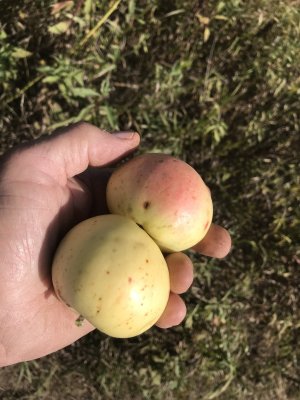
Rootstock apple. It tastes decent. I have no idea of variety as someone gave me the rootstock and couldn’t remember what they were.

Rootstock apple. It tastes decent. I have no idea of variety as someone gave me the rootstock and couldn’t remember what they were.
sandbur
5 year old buck +
I made a run outback to water some trees newly planted last spring and had to stop and sample 6-8 crab apples. It gets kind of hard on the stomach. I did post three of these on the dolgo versus dolgo seedling thread.
View attachment 57434
Rootstock apple. It tastes decent. I have no idea of variety as someone gave me the rootstock and couldn’t remember what they were.

This seedling looks like a chestnut and perhaps that is in the parentage. Chestnut Crab has dropped most of their fruit, but this so holding and has a sharper, more acid taste than chestnut crab. A few years ago, I decided to call this Sharp Dog.
sandbur
5 year old buck +
View attachment 57435
This seedling looks like a chestnut and perhaps that is in the parentage. Chestnut Crab has dropped most of their fruit, but this so holding and has a sharper, more acid taste than chestnut crab. A few years ago, I decided to call this Sharp Dog.
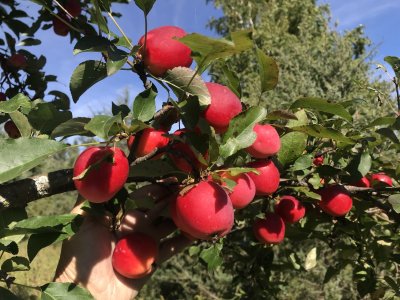
This is the dolgo seedling that I call Clown Nose. I have other pictures of the fruit on the dolgo versus dolgo seedling thread. Fruit on the less sunny sides of the tree has more yellow.
sandbur
5 year old buck +
View attachment 57436
This is the dolgo seedling that I call Clown Nose. I have other pictures of the fruit on the dolgo versus dolgo seedling thread. Fruit on the less sunny sides of the tree has more yellow.
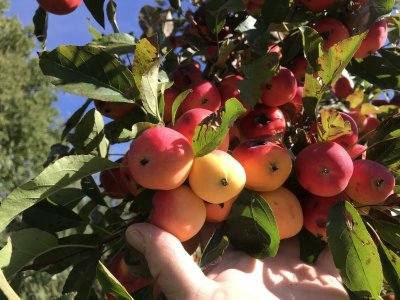
4wanderingeyes
5 year old buck +
I have several chestnut apple trees, and I have notice mid to late August they taste the best, I still have a few hanging on them, but they have gotten tart now. I thought maybe they were Witney crabs, but they look different.

